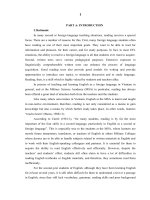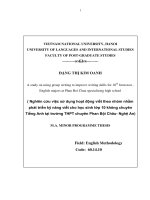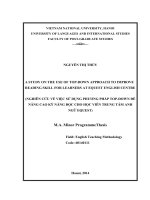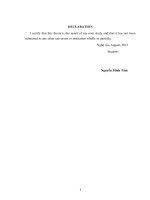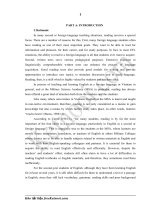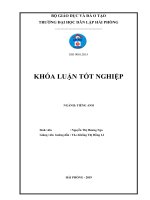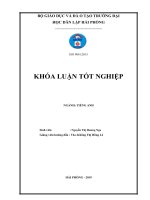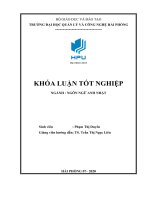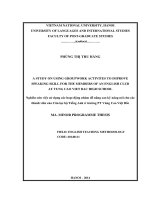Đề tài: A study on possible effective pre-reading activities to improve reading skill for the second- year english majors at the Tay Nguyen university
Bạn đang xem bản rút gọn của tài liệu. Xem và tải ngay bản đầy đủ của tài liệu tại đây (297.33 KB, 28 trang )
<span class="text_page_counter">Trang 1</span><div class="page_container" data-page="1">
This graduation assignment would not have been successful without the kindsupport and help of many individuals and organizations to whom I would like toextend my sincere thanks.
First and foremost, I would like to thank my research supervisors, Nguyen,MA. Without her assistance and dedicated involvement in every step throughout theprocess, this paper could have never been accomplished. She raised many preciouspoints in our discussion and I hope that I have managed to address several of themhere. She supported me with statistical analysis in this thesis and were very patientwith me.
I would also like to show gratitude all the teachers in Tay Nguyen University(TNU), who taught me carefully and for their guidance and constant supervision aswell as for providing necessary information regarding the program and also for theirsupport in completing the graduation assignment.
In addition, I would also like to thank the students of 2 English major classes(K22A & K22B) for participating in the questionnaire survey. I am extremelygrateful to you for supporting and understanding me during the past time.
Finally, I would like to thank everybody who supported and help me when Ineed and I hope that I can receive opinions from all the people to complete theassignment with the best standard.
Thank you so much for all you have give me!
<b>Student</b>
</div><span class="text_page_counter">Trang 2</span><div class="page_container" data-page="2"><b>CHAPTER 1. INTRODUCTION1.1. Statement of the problem</b>
In many second language teaching situations, reading is usually the languageskill that we especially focus on to learn. This is the most prominent language skill.There are a number of reasons for this. First, Reading is fun-way to knowledge hunt- reading brings wisdom. Through reading, we learn a lot so many foreign languagestudents often have reading as one of their most important goals. They want to beable to read for information and pleasure, for their career, and for study purposes. Infact, in most English as a foreign language situations, the ability to read in a foreignlanguage is all that students ever want to acquire.
Second, Reading is an essential skill in second-language acquisition. Aslearners develop their reading skills, they not only build their vocabulary, but theyalso become familiar with common grammatical structures and phrasing in thetarget language. Learners can transfer this knowledge to the other three basic skills-listening, speaking, and writing-and see their overall fluency improve. Reading istherefore a highly valuable skill and activity by students and teachers alike, and it isrecommended that English learners try to read as much as possible in English.
Like many other universities in Vietnam, English at the TNU is learnt andtaught in non-native environment, therefore, reading is not only considered as ameans to gain knowledge but also a means by which further study takes place. Soreading has always been offered a great deal of attention both from the teachers andthe students.
<b>1.2. Significance of the study</b>
According to Carrel, “for many students, reading is by far the most importantof the four skills in a second language, particularly in English as a second or foreignlanguage”. This is especially true to the students at the TNU, mainly students withthe desire to be able to handle topics related to documents written in English andwork with their English speakers. However, despite the teachers’ and students’effort, students still often claim to have a lot of difficulties in reading English
</div><span class="text_page_counter">Trang 3</span><div class="page_container" data-page="3">textbooks or English materials, and therefore, they sometimes read theminefficiently.
For the second-year students of English, although they have been learningEnglish for at least several years, it is still often difficult for them to understand atext or a passage in English, since they still lack vocabulary, grammar, readingskills and poor background knowledge. Besides, the teachers sometimes have toface with difficulties in dealing with the students’ learning demand and newlyintroduced sources of materials. In addition, teaching methods and teachingtechniques in general, are still below the international standard of education. To findout the areas of students’ difficulty at the TNU and the causes of their unsuccessfulreading comprehension is necessary. Therefore, these reasons have inspired thewriting of A Study on possible effective pre-reading activities to improve readingskills for the 2nd -year English Majors at the Tay Nguyen University. It is hopedthat the study will make some contributions to improve the learning of English ingeneral, and the learning of reading in particular among the 2nd-year Englishmajors at the TNU.
<b>1.3. Objectives of the study</b>
The main purposes of the study are to investigate attitudes towards pre-readingactivities employed by teachers for 2nd- year English majored students at TNU, andto give a suggestion of some possible pre- reading activities that can be applied toteach the text book more effectively to the second-year students of English at theTNU.
<b>1.4. Outline of the study</b>
The study is composed of five chapter:
Chapter 1 - Introduction provides statement, significance, objectives, scope,and outline of the study.
Chapter 2 - Literature review, conceptualizes the study’s theoreticalbackground, presents the concepts relevant to the topic of the thesis: reading andreading comprehension, role of reading in foreign language learning, motivationand factors in teaching and learning reading.
</div><span class="text_page_counter">Trang 4</span><div class="page_container" data-page="4">Chapter 3 - The study, presents the methodology used in the study. It alsoshows the detailed results of the survey and covers a comprehensive analysis on thedata collected form questionnaires.
Chapter 4 - offers some major findings and discussion of some possible reading activities which are thought to be helpful for teaching reading to the 2nd-year students of English at the TNU.
Pre-Chapter 5 - Conclusion is a review of the study, future directions for furtherresearch and limitations of the study as well.
</div><span class="text_page_counter">Trang 5</span><div class="page_container" data-page="5"><b>CHAPTER 2. LITERATURE REVIEW2.1. Definitions of reading and reading comprehension</b>
<i><b>2.1.1. Definition of reading</b></i>
Reading is one of the language skills (listening, reading, writing, andspeaking) which is important to be learned and mastered by every individual."Reading" is the process of looking at a series of written symbols and gettingmeaning from them. When we read, we use our eyes to receive written symbols(letters, punctuation marks and spaces) and we use our brain to convert them intowords, sentences and paragraphs that communicate something to us. By reading,one can interect with feelings and thoughts, obtain information and improve thescience knowledge. Therefore, reading activity is closely related with learningprocess.
According to Tarigan (1998:7) reading is a process which is used by a readerin order to get the purpose of the writer through the written word. Thorndike inNurhadi (2000:13) argues that reading is process in thinking and reasoning. Itmeans that when a reader reads a text, he uses his brain to think and reason out.Based on the definition above the writer gets conclusion that reading can be definedas a complex process that is done by a reader to comprehend the writer’s purposes.Reading can be silent (in our head) or aloud (so that other people can hear).
We cannot be sure when reading activity begins, but we have to admit thatreading is essential activity that provides a great contribution in obtainingknowledge. It is obvious that in real life we usually spend much time reading allsorts of things like books, magazines, newspapers, novels, stories. However,sometimes we read but we do not understand what they mean, or can not understandthe text we read. In this case, reading is also a productive skill in that we are bothreceiving information and transmitting it (even if only to ourselves).
Reading involves a reader, a text, and a writer. Reading skills are developed inan active process. This process involves the surface representation encoded by awriter and ends with interpretation of the written text and interchanges between thewriter and the reader (Goodman 1969 in Carrell 1988). If the writer is careless, thereader may not get the message. If the writer makes demands that the reader cannot
</div><span class="text_page_counter">Trang 6</span><div class="page_container" data-page="6">fulfill, the message will not be received, even though to another reader it might beclear. If the reader is careless, reading will result in incomplete interpretation. Thereader tries to interpret the text through his/her own experiences, but they maydiffer from the writer’s experiences. This explanation proves that reading is not justan active process, but also an interactive one. Reading is closely linked withmeaning. For this reason, lack of shared assumptions presents the most difficultproblem in reading.
To sum up, from all these opinions above, it is obvious that no definition canpossibly capture all the ideas and features of what reading is. Each linguist’sdefinition reflects what reading means as seen from his own point of view.However, they all have some features in common, they share the same ideas thatreading means we-the readers read the author’s mind not author’s word, and thatreading means comprehending written language and it employs a variety of skills.In addition, they all concentrate on the nature of reading.
<i><b>2.1.2. Definition of reading comprehension</b></i>
One of the types of reading which is often used in language learning inuniversity level is reading comprehension. Reading comprehension is aimed tounderstand the content of a text and the search of information in a text. Besides,reading comprehension can also give information about ideas, facts, theories whichfunction as source of knowledge and reading experience, and literary work.
According to Richard and Thomas (1987: 9), “Reading comprehension is bestdescribed as an understanding between the author and the reader”. This point ofview concentrates on the reader’s understanding of the message based on theindividual’s background knowledge. They stated that “reading is much more thanjust pronouncing words correctly or simply knowing what the author intends: it isthe process whereby the printed pages stimulate ideas, experiences and responsesthat are unique to an individual.”
In his book, Swan (1975: 1) pointed out that “A student is good atcomprehension we mean that he can read accurately and efficiently, so as to get themaximum information of a text with the minimum of understanding”. For Roe,Stood and Burns (1987: 9) Reading comprehension is reconstruction, interpretation,
</div><span class="text_page_counter">Trang 7</span><div class="page_container" data-page="7">and evaluation of what author of written content means by using knowledge gainedfrom life experience.
Study the nature of reading comprehension, Grilled (1981: 3) indicated that“Reading comprehension or understanding written text means extracting therequired information from it as effectively as possible”. This means that the studentcan show his understanding by re-expressing the content of the text in many wayssuch as summarizing the text, answering questions etc.
From these theories above, it can be understood that reading forcomprehension is the primary purpose for reading; raising students' awareness ofmain ideas in a text and exploring the organization of a text are essential for goodcomprehension. It is the process in which the readers - as they read, can recognizethe graphic form and understand the relation between the writing and the meaning.It means that after reading, students can master grammar structures, words,pronunciation etc and can understand the content of the text and use it in their reallife as effective as possible. Furthermore, “reading without comprehension is themeaningless” (Karolin and Karin, 1988: 2). Reading means comprehending writtenlanguage so when understanding break down, reading actually does not occur.
<b>2.2. Role of reading in foreign language learning</b>
In the process of teaching and learning a second or foreign language, theteaching and learning of reading are always received much attention, since it isregarded as one of the most important major skills as what Carrell (1971: 1) stated:“for many students, reading is by far the most important of the four macro skills,particularly in English as a second or foreign language”. This is also true for theTNU, because at our academy, reading is an active skill namely speaking, listeningand writing. To master reading skill is always challenging task that requires studentsa number of factors: a good competence of English grammar, rich vocabulary, andreading techniques. First of all, reading helps students learn to think in English,enlarge their English vocabulary, improve their writing. Richard (1993:4) claimedthat “reading may help to increase knowledge of the target language throughexposure to new vocabulary and grammatical structures”. There is a closerelationship between reading and vocabulary knowledge, because while reading, the
</div><span class="text_page_counter">Trang 8</span><div class="page_container" data-page="8">readers know most of the words in the text already, and they can also determine themeaning of many of the unfamiliar words from the contexts. Therefore, the bestway to acquire a large vocabulary is to read. It is understandable that anyone whohas a large vocabulary is usually a good reader.
Besides, Richard (1993: 4) also stated that “reading in the new language isalso an important way to learn about the target culture”, which means that readingprovides the students with a wide range of interesting information, helps themunderstand the ways of life, behaviors, thoughts and other aspect of the nativepeople and it is also a good way to find out about new ideas, facts and experiences.Therefore, they can master vocabulary, grammar and the background knowledge orcross-cultural problems that they encounter. In other words, reading is veryimportant to the foreign language learners because it widen their knowledge oflanguage and life. In the context of TNU, it seems to be the most important skill tothe students of English since their main purpose is to understand the written texts.
<b>2.3. Teaching and learning reading skills</b>
<i><b>2.3.1. Teaching reading skill</b></i>
Many linguistics state that the teacher is the most important factor in teachingreading. In a reading class, the teacher plays so many roles, such as an organizer, amanager and a counselor, an instructional expert, so he or she should be a guide toassist, encourage them, employ various types to support the students developreading skills. He or she also the person who provides the students with an anxiety-free atmosphere which helps them feel free to join new reading style, practice tomaster new strategies, work under pressure of time.
Besides, in reading lesson, students are supposed to understand the textscorrectly as much as possible, learn some new language. Therefore, in teachingreading, the teacher should pay much attention to the following aspects such aslanguage content, vocabulary and grammatical structures, types of readingactivities, though it is not simple thing to do because providing suitable texts takestime, effort and some expertise.
</div><span class="text_page_counter">Trang 9</span><div class="page_container" data-page="9"><i><b>2.3.2. Learning reading skill</b></i>
There are 4 factors that affect students' learning to read. That is the Studentsthemselves, motivation, perception and reading material.
<b>Obviously, students themselves play an important role in improving their</b>
own reading skills. First, they should “take an active part in reading”. This is thefirst and foremost responsibility of the learners. They have to be active and takecharge of what they do. Second, students have to take the risk of making mistakesbecause a mistake is an opportunity to learn. The next thing is “monitoringcomprehension”, which means students need to understand how texts work andwhat they do when they read. They have to learn how to carry on a dialogue withthe text. The last thing for them to do is learning not to cheat oneself, students whodo not want to learn to read can easily cheat, but in fact, they are cheatingthemselves, it is just a waste of time and their opportunities as well.
<b>Motivation is one of the main determining factors in success in foreign or</b>
second language learning. You can realize that you are more engaged when you arereading something that interests you. There are many factors that can help youbecome interested in what you are reading, such as: your thoughts, feelings,interests, and your background knowledge. Reading motivation refers to the desireto read, even when not required to do so. Reading motivation involves seeking outopportunities to read for curiosity, knowledge, and involvement. Researchers, whostudy on reading, recognize that in order to create lifelong readers, endowing thelearners with proficient reading are not enough. They also need to have internalizedmotivation.
<b>Perception is the process of receiving information about and making sense of</b>
the world around us. People will give their responses to stimuli from thesurroundings. Therefore, people’s perception about something will influence theway they response about something, whether it is positive or negative. The researchof the students’ perception on pre-reading activities is worth doing to know thestudents perception on the teaching instructions implemented by the teacher. If thestudents perceived positively toward the teaching techniques used by the teacher,they will think that the teaching techniques are helpful and important for them to be
</div><span class="text_page_counter">Trang 10</span><div class="page_container" data-page="10">successful in the reading class. The students will show their interest to the reading activities. On the other hand, if the students respond to the instructionsnegatively, the students are not interested to the pre-reading activities. The students’perception on pre-reading activities which are based on their experiences will affecttheir way of thinking or interpreting the pre-reading activities implemented by theteacher.
<b>pre-Besides, reading material is also another important factor of that greatly</b>
influences the learning reading skill, because through them new grammar, phoneticand lexical items of the target language are introduced. Furthermore, texts are alsomeans to help students enrich their background knowledge and vocabulary as well.In reading lesson, students are supposed to understand the texts correctly as much aspossible, learn some new language items e.g. words, structures, and use what theyhave got from the text through reading tasks and communication activities thatfollow.
<b>2.4. The importance of the Pre-reading activities in a reading lesson</b>
Pre-reading is the process of skimming a text to locate key ideas beforecarefully reading a text (or a chapter of a text) from start to finish. Also called previewing or surveying.
Pre-reading provides an overview that can increase reading speed andefficiency. Pre-reading typically involves looking at (and thinking about) titles,chapter introductions, summaries, headings, subheadings, study questions,and conclusions.
Alan Jacobs states that "to be successful today, it not only becomes necessaryto skim, but it becomes essential to skim well". Pre-reading activities as activitiesthat help students with cultural background, stimulate student interest in the story,and pre-teach vocabulary.
It can not be denied that Pre-reading activities play a crucial important role inmotivating the students through the reading lesson. The aim of using Pre-readingactivities is to develop a better self-awareness of the relationship between thereader’s meaning and the author’s meaning; to help readers understand the teacher’sexpectations and views; to activate the reader’s background knowledge, and to
</div><span class="text_page_counter">Trang 11</span><div class="page_container" data-page="11">prevent failure, and to support the reader’s interpretation of the text. EmployingPre-reading activities in the first stage of the reading lesson can promote interactionbetween the reader and the text. Pre-reading activities is to provide anticipation andactivate reader in the next stages of the reading process.
</div><span class="text_page_counter">Trang 12</span><div class="page_container" data-page="12"><b>CHAPTER 3. METHODOLOGY3.1. Subjects of the study</b>
The 80 students under investigation are in the second term of the second yearat the Faculties of Foreign Languages, TNU.These students’ ages are between 20and 22 years old. They are supposed to have quite an equal knowledge of Englishbefore entering the TNU since most of them have learnt English for at least 9 years(from grade 3 to grade 12 at school). Moreover, they all passed a very challengingentrance exam. Some of them come from Dak Lak, the rest come from differentprovinces around the country. These students were chosen from 120 second yearstudents during the school year of 2022-2023. They have completed their first threeterms of the four-year course. Of course, it was very difficult to select a sample ofindividuals since the students had already assigned to two different classes.
<b>3.2. Scope of the study</b>
To improve reading skill for students of English at the TNU, the teachers canmake use of various techniques and number of things should be done. However, inthis study, the author only intends to overview a brief of current situation oflearning reading of the 2nd-year students of English at the TNU, and to suggestsome possible activities that can be applied in the Pre-reading stage in order tomotivate students in reading lesson as well as help them to become good andeffective readers.
<b>3.3. Research questions</b>
There are two questions in this study:
1. What pre-activities in reading lessons do teachers often use? 2. What are the students’ preferences for these pre-reading activities?
<b>3.4. Research methodsQuestionnaire</b>
The findings are collected through questionnaires. Using questionnaire allowsthe researcher to collect the data needed in quantitative form. Besides, theresearcher finds it quite easy to summarize, analyze, and report the collected databecause all informants answer the same questions. Moreover, the informants are
</div><span class="text_page_counter">Trang 13</span><div class="page_container" data-page="13">provided with an opportunity to express their attitudes towards teaching andlearning reading skills openly.
This study was conducted at TNU, where the author is studying. Theuniversity has been in operation for almost fifty years. English is just one of manyother majors taught. Students must go through a four-year course to learn bothfoundational and specialized knowledge.
The author of the study randomly chose 2 classes majoring in English (K22A& K22B) to participate in the survey using a questionnaire. This study focuses onpre-reading activities that are employed by the teachers of English at the TNU toimprove reading skills for the second-year English majored students.
<b>Instrument </b>
The questionnaire consists of 7 questions, divided into three parts.
Part 1 (questions 1, 2, and 3) seeks to understand students' attitudes towardtechniques and pre-reading activities often used by teachers.
In part 2, responses to questions 4, 5 and 6 were conducted to find out theirinvolvement in the activity and their interaction with each other while completingthe tasks.
In the final part of the questionnaire (questions 7) seeks to the students’reactions to Pre-reading activities employed in the lesson as well as theirpreferences for these techniques. Hopefully it can help the researcher to givesuggestions to provide some more Pre-reading activities for students.
<b>Data collection</b>
The questionnaire is made online by google form so that it is distributed tothe student of two classes which are Bachelor of English and Pedagogy of Englishcourse 18 by a link. Students were given clear instructions and explanation forfilling out the questionnaire. The questionnaires were then collected automaticallyupon completion.
<b> Data analysis </b>
The data obtained from the questionnaires were analyzed through Excel 2010Office Version. The data concerning subjects’ general background as well as theircomments were calculated and presented in percentage.
</div><span class="text_page_counter">Trang 14</span><div class="page_container" data-page="14"><b>CHAPTER 4. FINDINGS AND DISCUSSION</b>
<b>4.1. Pre-reading activities that teachers often use in teaching reading lessons</b>
<i>From the result of Question 2 (What does your teacher often do to begin areading lesson?) focuses on the necessity of the activities that should be done</i>
before reading the text. About 70% of the students state that their teachers organizesome Pre-reading activities. It is obvious that the students are aware of theimportance of these activities and they regard them as inevitable factor in almostreading lessons. Nearly 30% of the students report that they are asked to read thetext without preparation. This may due to the teachers’ own ways of teaching orbecause of the time constraint.
<i>Chart 1 below gives the facts to the question 4 (Which of the following reading activities does your teacher use in reading lesson?)</i>
<small>Pre-Predict the content of the textPre-teaching new vocabularyPre-Questioning Introduce the reading text Visual Aids and KWL Strategy 0</small>
<i><b>Chart 1: Frequency of using Pre-reading activities by the teachers (%)</b></i>
Look at the Chart 1, we can be seen that teachers used the varieties of reading activities as follows: predict the content of the text, pre-teaching newvocabulary, pre-Questioning, giving a brief introduction to the text, visual aids andKWL strategy. The teachers are able to select the appropriate pre-reading activityrelated to the reading text to teach reading effectively. Or, the teachers are also able
<i>pre-to combine some of the pre-reading activities in the pre-reading stage. From the</i>
</div>